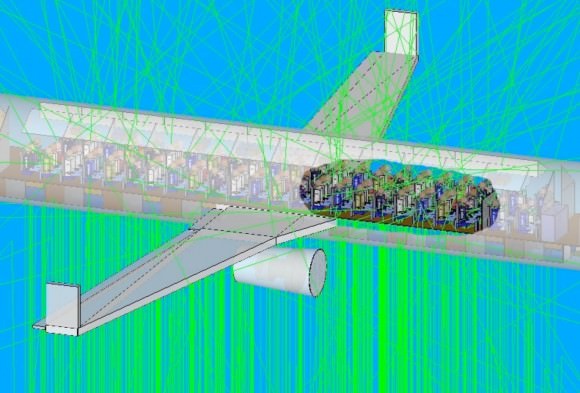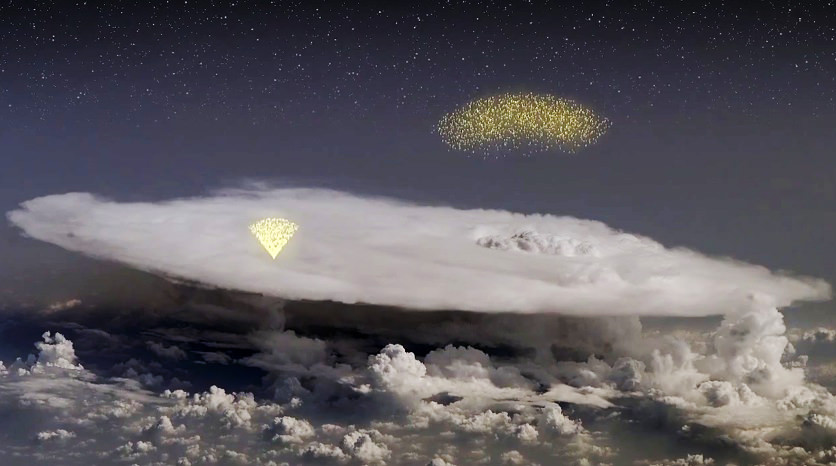Discovered “by accident” by NASA’s Fermi Gamma-ray Space Telescope in 2010, dark lightning is a surprisingly powerful — yet invisible — by-product of thunderstorms in Earth’s atmosphere. Like regular lightning, dark lightning is the result of a natural process of charged particles within storm clouds trying to cancel out opposing charges. Unlike normal lightning, though, dark lightning is invisible to our eyes and doesn’t radiate heat or light — instead, it releases bursts of gamma radiation.
What’s more, these gamma-ray outbursts originate at relatively low altitudes well within the storm clouds themselves. This means that airplane pilots and passengers flying through thunderstorms may be getting exposed to gamma rays from dark lightning, which are energetic enough to pass through the hull of an aircraft… as well as anything or anyone inside it. To find out how such exposure to dark lightning could affect air travelers, the U.S. Naval Research Laboratory (NRL) is conducting computer modeling tests using their SoftWare for the Optimization of Radiation Detectors — SWORD, for short.
Terrestrial Gamma-ray Flashes (TGFs) are extremely intense, sub-millisecond bursts of gamma rays and particle beams of matter and anti-matter. First identified in 1994, they are associated with strong thunderstorms and lightning, although scientists do not fully understand the details of the relationship to lightning. The latest theoretical models of TGFs suggest that the particle accelerator that creates the gamma rays is located deep within the atmosphere, at altitudes between six and ten miles, inside thunderclouds and within reach of civilian and military aircraft.
These models also suggest that the particle beams are intense enough to distort and collapse the electric field within thunderstorms and may, therefore, play an important role in regulating the production of visible lightning. Unlike visible lightning, TGF beams are sufficiently broad — perhaps about half a mile wide at the top of the thunderstorm — that they do not create a hot plasma channel and optical flash; hence the name, “dark lightning.”
A team of NRL Space Science Division researchers, led by Dr. J. Eric Grove of the High Energy Space Environment (HESE) Branch, is studying the radiation environment in the vicinity of thunderstorms and dark lightning flashes. Using the Calorimeter built by NRL on NASA’s Fermi Gamma-ray Space Telescope they are measuring the energy content of dark lightning and, for the first time, using gamma rays to geolocate the flashes.
As a next step, Dr. Chul Gwon of the HESE Branch is using NRL’s SoftWare for the Optimization of Radiation Detectors (SWORD) to create the first-ever simulations of a dark lightning flash striking a Boeing 737. He can calculate the radiation dosage to the passengers and crew from these Monte Carlo simulations. Previous estimates have indicated it could be as high as the equivalent of hundreds of chest X-rays, depending on the intensity of the flash and the distance to the source.

(Credit: U.S. Naval Research Laboratory)
SWORD simulations allow researchers to study in detail the effects of variation in intensity, spectrum, and geometry of the flash. Dr. Grover’s team is now assembling detectors that will be flown on balloons and specialized aircraft into thunderstorms to measure the gamma ray flux in situ. The first balloon flights are scheduled to take place this summer.
Source: NRL News


Isn’t it a good idea for planes to avoid flying through thunderstorms anyway?
Yes, but I’m sure sometimes they end up inside or above them anyway.
I can remember a few times where my plane was forced to circle around an airport in a thunderstorm since it had shut down traffic in and out. Little did I know the skies hid a minefield of harmful gamma ray bursts that could have stuck the plane at any time. Flight crews must be squirming since this kind of thing probably happened to them a thousand times during their careers. Has anyone studied the cancer rates of flight crews plotted over flight time? Is anyone doing studies with gamma ray detectors on planes to determine the frequency of such strikes on planes?
I’m guessing that the increased exposure to cosmic rays would dwarf these since they won’t occur all that often, but I suppose it all adds up.
In the worst case scenario, an unlucky passenger could receive the lifetime safe dose of ionizing radiation in a single burst.
Try tin-foil lining for your pants.
and what about ISS crew who live for continuous six months above earth?
You raise a good point. You would want the space station orbiting as far away from thunderstorm prone areas as possible. Torbjorn Larsson also posted below that there are regional hot spots (perhaps related to the orientation of Earth’s magnetic field.) More studies are needed to gather the necessary data about the magnitude of the threat this poses. I can say now that the threat is significant enough that the research needs to be done. The Navy apparently realizes this for obvious reasons: they have pilots in the air all over the globe. Kudos for them for taking the lead by launching this research mission.
Buzzzzap! This info is just too cool! Don’t you love it when something totally unexpected is revealed by science? I can’t help but wonder if similar processes are happening at Jupiter and the other gas giants?
That was just from the tiny bottles of vodka. 😉
LOL! Now THAT’s the only way to fly! At least for me anyway…
Gamma rays, the green kryptonite of men. You can’t outrun them, you can’t dodge them.
But it turns out we likely could have a warning system akin to tornado warnings. This paper places the initiating relativistic electron beams above the rarer but more powerful positive cloud-to-ground lightning. Apparently it can be detected by radio.
Pro tip: Avoid flying above Sweden and, I presume, Canada and Russia. IIRC, at least in Sweden the positive CG lighting is more frequent than elsewhere. If it is tied to climate, that would be the zone to watch out for.
Do a few miles of air stop those gamma rays? Or do they reach the ground?
Because these photons are generated by bremsstrahlung, aren’t these, strictly speaking, X-rays, not gamma rays?
Shouldn’t we have thousands of Hulks by now? Constantly? Mutant superheroes by the myriad?
No. Just me.